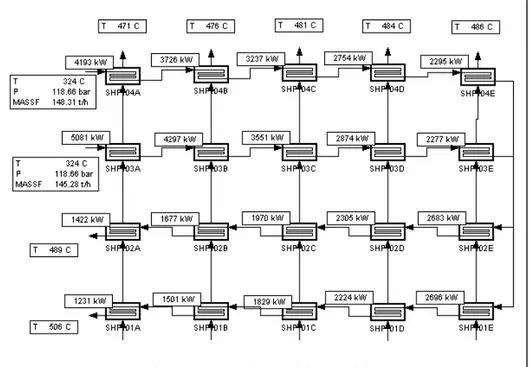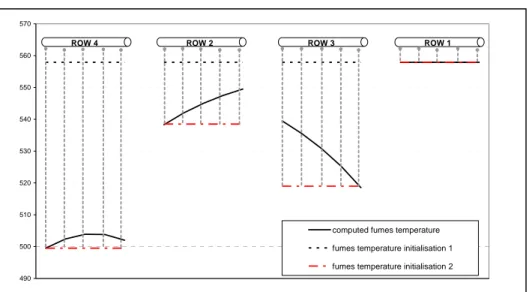V. Plesu and P.S. Agachi (Editors)
© 2007 Elsevier B.V./Ltd. All rights reserved.
Row by row simulation of heat recovery steam
generators : comparing different types of
initialization as well as the LMTD and ε-NTU
simulation methods.
Marie-Noëlle Dumont,a Georges Heyen a
a
Laboratoire d’Analyse et de Synthèse des Systèmes Chimiques (University of Liège), Institut de Chimie, B6A, Sart Tilman, B-4000 Liège, Belgium, MN.Dumont@ulg.ac.be
Abstract
We developed a model which makes it possible to simulate a boiler rows by row. This model as well uses the European approach of log mean temperature difference as the American approach of effectiveness-number of transfer unit. These approaches are compared in term of results and speed of calculation. We also present the difficulties encountered and some means of circumventing them. Some cases of superheater are treated in order to illustrate our matter. Keywords
HRSG, LMTD method, ε -NTU method, convergence problems 1. Introduction
Heat recovery steam generators (HRSG) play a very important role in combined cycle (CC) power plants, where steam is generated from a gas turbine exhaust and supplied steam at the appropriate pressure and temperature to steam turbines for further power generation. The power plants achieve an overall efficiency above 55% and are ideally suited for combined heat and power generation in utility systems.
The performance of energy conversion is improved by reducing exergy losses. Thus recent HRSG designs include up to four pressure levels with reheat in the steam cycle for maximum energy recovery and the use of high pressure, high temperature superheater and reheater in CC plants. Super critical boilers are also
conceivable.The examples treated in this text are superheaters from the HRSG of a CC with 3 levels of pressure.
Since HRSG performance has a large impact on the overall efficiency of the CC power plant, an accurate simulation of the performance of the HRSG is necessary.
We present a steady state HRSG model to support design and rating simulations of horizontal units. The model divides the boiler in its rows. The row model can also be divided several times following the tube length, to better estimate the fumes temperature distribution across the hot gas path.
The log mean temperature difference (LMTD) method and the effectiveness-NTU (ε -effectiveness-NTU) method are alternatively used to compute the overall heat transferred on each part of the HRSG.
The problem of convergence of boiler models with more than one row in parallel is discussed. The initialisation of the different variables is crucial to obtain convergence.
Some particular cases of reheaters and superheaters with several rows in parallel are computed. The two methods are compared in high-pressure superheater. Since this work is performed in collaboration with a HRSG manufacturer, we have access to actual plant data. The computed results are compared with in situ measurements obtained in power plant.
2. Problem Statement
To calculate a HRSG, the manufacturers are often satisfied to calculate each module of the boiler: the economiser, the vaporiser and the superheater. The empirical equations used are perfectly adjusted and allow an excellent estimation of the power of the boiler.
In certain case, this approach is not enough. For example, to understand why a
superheater does not provide the expected thermal power, it is interesting to know the distribution of vapor flows in the various tubes. To know if the material chosen for the tubes will be well adapted to the temperature of the fume, it is necessary to know the temperature of the hottest tube, etc.
To summarise, the temperatures do not evolve linearly in a boiler and the knowledge of this non-linearity makes it possible to still improve the performances of the boiler and thus to make it economically more profitable. This is why, we developed a model which subdivides the boiler in its rows. Figures 1 and 2 show the same HP superheater, the second being subdivided 20 times for better understanding the change of the temperatures inside the bundle of tubes.
There are various methods to estimate the heat flow exchanged between two fluids in an heat exchanger. The two methods most usually employed are the LMTD method [1], based on the variation of the logarithmic mean temperature calculated by means of the expression
ln
a b a bT
T
TLM
T
T
Δ − Δ
Δ
=
Δ
Δ
(Eqn. nr. 1)resulting from the study of the exchangers with parallel current and the NTU method, the number of unit of transfer [2], based on the expression of the
maximum heat flux on the one hand and the effectiveness of the exchanger on the other hand. The two methods were implemented in our model. They give the same results and in certain borderline cases (crossing of temperature for example) can be complementary one of the other.
3. Alternative solution methods
3.1. Case study
We took as example a superheater HP (120 bar) composed of 4 rows (2 rows in parallel) of 125 finned tubes 38 mm diameter and 20,455 m length having a total heat-transfer surface of 14732 m ², 2132 t/h of combustion gas at 558°C must superheat 293.5 t/h of steam from 324°C until 498°C.
The superheater was calculated with 4 modules (case 1, 80 equations), 20 modules (case 2, 335 equations) and 40 modules (case 3, 640 equations).
3.2. Initialisation
With LMTD method, the initialization of the variables (temperature, load), whatever the case considered, is essential to obtain a solution. On the other hand, NTU method is more robust but also requires a correct intialisation of the variables of the problem when the number of equations becomes extremely high (case 3). Figures 3 & 4 show how the evolution of the sum of squares of residuals of the equation system changes with the iteration count ( case 1 without initialisation).
First of all, we have initialized the temperatures everywhere equal to the inlet temperatures. When there is a large number of equations, this type of initialization is not enough. We have then computed a thermal load identical (and feasible) on each module and introduced a mode of calculation of the system with constant load in order to introduce plausible initial temperatures everywhere into the system.
Figure 4 : Convergence NTU Figure 3 : No convergence LMTD
On Figure 5 (case 2), one can see the evolution of the value of the fumes temperature at the entry of each row of tubes with the two types of initialization as well as at convergence.
3.3. LMTD or NTU?
The LMTD and NTU methods give the same results but a very clear difference appears on the speed of convergence. Once the good method of initialization of the variables was applied, LMTD converges much more quickly than NTU (table 1).
To solve simultaneously the great number of equations generated by the system, 2 methods of resolution were used: the first is a version of optimizer SQPIP [3] and the second solver based on Han-Powell algorithm (SOLDOG)[4].
The table 1 gives the speed of resolution (in time CPU with intel pentium M, processor 1.6 GHz, 592 MHz, 504 Mo RAM) for the various cases considered. One carried out modifications of the conditions of entry to see how the resolution with LMTD and NTU was affected. First, one modified the water flow inside the tube while in second, one modified the temperature of the fume
490 500 510 520 530 540 550 560 570
computed fumes temperature fumes temperature initialisation 1 fumes temperature initialisation 2
ROW 1
ROW 4 ROW 2 ROW 3
Figure 5 : Fumes inlet temperature initialisation
LMTD NTU SOLDOG SQPIP SOLDOG SQPIP
CASE 1 0.78 1.9 2.0 4.7
CASE 2 4.83 9.4 33.3 84.6
CASE 3 8.76 18.5 102.2 237.8
at the entry of the superheater.
To converge, LMTD needs a plausible initialization. If one divides the water flow by 2, water will be even hotter. Although distant, the initialization with the basic case data is thus not bad. On the other hand, if one multiplies the flows by 2, a possible crossing of temperature can appear during convergence. It is difficult to solve with LMTD (equivalent with a bad initialization). It is consequently necessary to set out again of an initial point more plausible than the basic case data.
A change of temperature of the fume will be less difficult to solve as long as the new temperature of the fume remains higher than the temperature of exit of the steam of the basic case.
NTU is much more stable thanks to the type of equations to solve which take account only of the configuration of the exchanger, of the heat capacity of the involved fluids and the inlet temperatures of those fluids.
4. Conclusions
LMTD vs NTU, it is speed vs effectiveness. In the large majority of the encountered cases, the speed of convergence with LMTD will precede since the results obtained are similar. In some borderline cases (near to the point of vaporization) or when important modifications must be made to the boiler, one will choose the stability of convergence with NTU.
LMTD vs NTU, it is also rigorousity vs simplicity. If time assigned to calculate an exchanger is extremely limited or that no sufficiently effective solver is available to solve the equations generated by LMTD, since the solutions obtained are identical, one will not hesitate to choose NTU.
Whatever the method of resolution chosen, a good initialization of the variables of the system is necessary. An initialization with identical thermal load on each module is very simple to realize and very effective.
5. Acknowledgements
We would like thank CMI Utility boilers (Belgium) to have provided us the examples of this article like for their invaluable assistance at the time of the development of the module of calculation.
6. References
1. W. Roetzel and B.Spang, VDI heat atlas, VDI-Verlag,, Düsseldorf, Germany (1993) 2. A. Houberecht, La Thermodynamique technique, Ceuterick, Louvain, Belgium (1976) 3. D. Kyriakopoulou, PhD thesis, Liège, Belgium (1998)
4. Hern-Shann Chen and M.A. Stadtherr, On solving large sparse nonlinear equation systems, Computers and chemical engineering vol. 8, no1, pp. 1-7 (1984)



